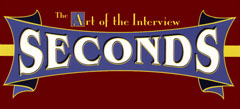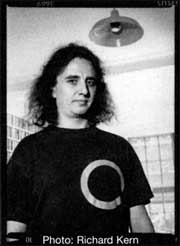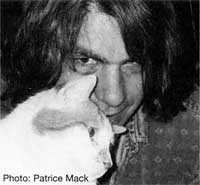|
About the Authors |
|
1. Steven Blush I moved to NYC in 1985, amped from the DC Hardcore Punk explosion and looking to make a difference. My first week here I stumbled into See Hear, a now-defunct zine store. After scanning the vast selection, I was floored by the smugness of all the self-proclaimed cutting-edge mags. Right then and there I knew it was time to make my own statement. So, in pure HC fashion – with no money or publishing experience – I founded SECONDS. Along the way, SECONDS accidentally developed a new lexicon of Rock criticism. The editorial struck a perfect balance – the artists were the stars because they spoke freely, the writers were the stars because they presided over the madness. Some have said SECONDS was the final frontier of gonzo journalism – the last spasms of that vaunted Jack Kerouac/Hunter Thompson trip, before all forms of rebellion were stomped out by the corporate powers that be. Who knows? A frequently asked question is "Why did you call the magazine SECONDS?" To me, "Rock" or "Alternative" or "Punk" as part of the title seemed lame and inappropriate. In '85 I became obsessed with the eerie Rock Hudson film Seconds and a Human League song of the same name. I've told some people SECONDS started as a zine devoted to the Reno HC band 7 Seconds but that's a lie. "Seconds" also related to the ticks of the clock that transpire during an interview – and the name "Time" was already taken. SECONDS created something out of nothing. There was no master plan – I flew from the seat of my pants so often I had skid marks. The magazine ascribed to the Black Flag business model: success in non-economic terms. Conventional criteria simply did not apply. The payoff was artistic accomplishment and ego gratification. But good ethics don't neccessarily make for good business practice. As there was zero capital investments or trust funds to fall back on, SECONDS never had a financial pot to piss in. Wherever I lived became the office. I'd give marketing presentations to labels, and get no play. Potential investors never asked for a follow-up meeting. Bounced check fees became a cost of doing business. The fact we were able to get on newsstands every month, smack next to all the slick Pop rags, was a miracle. If great art is a product of frustration, SECONDS was a fucking masterpiece. There were two distinct currents to SECONDS: my Punk/Metal bombast chock fulla HC bravado and Spinal Tap-isms; and the 1992 arrival of editor George Petros, with his psycho-intellectual world of astronauts, scientists, serial killers and hookers. GP was the most decadent fucker I'd ever met. We were a perfect tag team – ready to take on all comers. The Blush/Petros era of SECONDS warrants a book onto itself. Call it Woodward and Bernstein meets Cheech & Chong. High-octane hooch truly propelled the project. Effects of heavy usage include paranoia and delusions of grandeur–we thought everyone hated us, and knew that we were the shit. There's so many amazing tales: Fear and Loathing-style road trips; the world's dumbest police dog; Glenn Danzig, White Aryan Resistance and the ADL; GP mistaking a photo messenger for the weed delivery; telling Limp Bizkit their name was too stupid to be in the mag; the late Anton LaVey, my biggest supporter; endless psychodrama with the dumb-ass ex; blowin' chunks on I-10; crack cocaine episodes; and Richard Luckett. Next time I see ya, let me fill ya in on the details ... SECONDS writers were an imposing lot, often more intense than their interview subjects. GP was incredible at cultivating writers, and harnessing weirdos–avowed fascists, drunks and others who'd never hack it at Rolling Stone–and getting their best work. You can't fuck with a staff that included Carlo McCormick, Michael Moynihan, Boyd Rice, Tamara Conniff, Arthur Deco, David Paul, Tom Terrell, Steven Cerio, Althea Morin, Spider, Adam Parfrey, R.N. Taylor, John Aes-Nihil, Dave Clark, Joseph Lanza, and David West. Our copy editor Jerry Williams, producer of the first Beastie Boys and Bad Brains records, relocated to the California desert to live out a Ted Kaczinski-style existence. Photographers like Richard Kern and Michael Lavine are now world renowned. Art directors Eric Hammer, Nancy Petros, Kim Seltzer, and Bobby Piersanti are case studies in themselves. But my greatest admiration goes to Adam Keane Stern, Tom Colbath, and Mike Mathieson, for keeping things running under some truly hellacious circumstances. In the end, SECONDS helped break many important bands. SECONDS #1 was the first-ever Beasties Boys cover, and Rick Rubin at Def Jam (who I knew from the HC scene) used the ink to launch Licensed To Ill. Rappers like Chuck D, KRS-One, and Q-Tip received their first Rock press herein. Future Rock Stars who received virgin ink with us include Marilyn Manson, Tool, Soundgarden, Pearl Jam, Rage Against The Machine, and Kyuss/Queens Of The Stone Age. SECONDS parties with Don Hill were breakout events for Monster Magnet, Fun Lovin' Criminals and Sugar Ray. Amongst the first-ever mag covers with Techno artists were The Orb (#24), Orbital (#29), Spooky (#49), and The DJs of Liquid Sky (#43). Death Metal and the Satanic underground found their only legit press in our pages. One very satisfying moment was holding court backstage at Ozzfest with a few of the headliners, with the knowledge that 50,000 fans were excited for these bands, and these bands were excited to hang with the SECONDS guy. My only regret with the mag was I should've dumbed things down, so that even the hipsters would get it. Suffice it to say, we alienated people with our outrageous editorial and flippant attitude. In certain circles, SECONDS was the North Korea of Rock mags. When the music biz went bust, it was time to get the fuck out. The whole industry went flat; it seemed like everyone just ran out of ideas. And what's the point of enthusiastically covering music if it's not bringing anything new to the game? By the Millenium, I was totally sick of it all (pun intended). SECONDS could've plodded along, but I had too much respect to not give it a proper burial. In the end, SECONDS was more than a cool blip in Rock history, it was a front row seat to the decline of Western Civilization. Ultimately, SECONDS transcended fanzinedom to become a legit magazine. Anyone down with the underground has heard of SECONDS or have seen an issue or two in their lives. It survived against all odds – 52 issues and 15 years of blood, sweat and jeers. Considering everything, we did damn well. SECONDS was the only newsstand mag done on a kitchen table. To some, that made us a joke. In certain ways, we definitely were a joke. But who's laughing now? – Steven Blush, NYC, October 2004 2. George Petros SECONDS Magazine stands as Pop Culture's coolest and smartest organ. For a decade and a half we presented interviews with intense and/or fabulous personalities of music, art, literature, film, crime, and science. We adopted the tag "The Art Of The Interview" in celebration of our unique style. From 1986 through 2000, few hipsters would deny that SECONDS ranked among their favorite mags. The magazine's lifespan paralleled very exciting times. From the streets came Rap; from captured electrons came Techno. Kaleidoscopic interbreeding of Rock styles yielded new varieties of Metal, Punk, Psychedelic and Glam. Grunge Rock engendered Indie and Alternative forms. Hip-Hop, Ambient, Acid Jazz, Trip Hop, Drum-N-Bass - all evolved energetically. Among that era's heroes were the engineers who ushered us into a Digital Age. CD technology opened up amazing archival opportunities that led to the re-issuing of yesteryear's musical gems; the cornucopia of musical history could be had for home listening. Nostalgia itself became a recognized musical genre. In the beginning SECONDS went to press as hastily-typeset "mechanicals" on stacks of shaggy, re-used boards. In the end a Mac G4 processed everything, spitting it out on two CDs. Very exciting times. I met Steven Blush on the Staten Island Ferry, not commuting to that distant borough but aboard attending a party thrown by Capitol Records for 1986's New Music Seminar. Capitol rented the ferry boat for the night; during the cruise Skinny Puppy debuted to the Rock cognoscenti. Steven handed out copies of SECONDS with true Eighties indie publishing spirit. In those days I did EXIT Magazine, so we sorta knew of each other through the grapevine. And, he knew Nancy Jean Keating, who later served as both the SECONDS art director and my wife for too brief a time. In the SECONDS universe, vice sat alongside virtue; good and evil coexisted. We helped major labels break bands while milking them for advertising revenue. We told people we liked their stuff even if we'd never heard it. We ran free ads for PETA and other animal rights organizations alongside interviews with serial killers. We burned printers. We were flown around the country, put up in luxury hotels, fed dinners at overpriced restaurants on unlimited expense accounts. We hung out into the wee hours with coked-out publicists; we had breakfast with beautiful radio astronomers. Music's biggest stars took time out of their busy schedules to schmooze us. But most of all we got lavished with respect and accolades because our interviews were the best. We set the standard for Rock Journalism. We got interviews with elusive and reclusive characters. We got our subjects to tell the truth. The magazine's strength stemmed from our contributors' skills. When I assumed editorship, publisher Steven Blush was the principal interviewer. Art critic Carlo McCormick often contributed interviews of the high and mighty. The first regularly-appearing interviewer I enticed on board was Althea Morin who, with the exceptions of this collection's editors and Mr. McCormick, served the magazine longer than anyone. She covered the Goth scene. Adam Keane Stern joined next, serving as the managing editor. He interviewed all sorts of interesting characters. Then came the author of Lords Of Chaos, Michael Moynihan, who reeled in some of our most compelling features. He reported from the point where Rock meets crime. The illustrator Steven Cerio interviewed prominent artists. Boyd Rice lent his wit to our pursuit of stars and diabolical entities. Tom Terrell wielded a feel for the funky, providing us with excellent coverage of cool shit. David Paul brought Classical and post-Modern music to life. Arthur Deco interviewed some of our nation's worst criminals, blessing our pages with mind-wrenching material. Tamara Conniff reported on hot and breaking acts; she came into the fold after our interview with her musician father Ray. Spider did some of Hard Rock's hardest characters. Michael Uman harnessed the new waves of nascent Electronica. No political potato was too hot to be handled by Robert N. Taylor. Nor was any taboo too sacred to be broken by that archivist of the insane, John Aes-Nihil. David West contributed hell-bent interviews, ferreting out his subjects' worst fears. Porn mogul David Aaron Clark's probing prickliness sparked controversy. Thomas Colbath, who served as art director, explored the psyches of art's biggest fish. Irwin Chusid investigated weirdness. Thomas Stanley covered Jazz and Urban. Phillip Carlo contributed his exclusive interview with Richard Ramirez. Many other excellent interviewers contributed to the magazine. Our failure to include them herein is not the result of any hierarchical selection. The interviews in this collection, for the most part, record verbal manifestations of insanity, criminality, egotism, and sheer will, or else they record moments of beauty from truly beautiful people. We worked with many interviewers who cranked out great stuff for us, but their subjects were nice, well-adjusted folk who didn't fit the mindset of this collection. Excellent interviewers with whom we worked but who are not represented herein include Eric Wielander, Chad Hensley, Jason Szostek, Brittany, Ken Scrudato, Tim Caldwell, Steve Martin, Michael Andros, Sal Canzonieri, Sarah Kate Wade, Maria Ma, and Terrence Fleming. The personnel: Publisher Steven Blush conducted the lion's share of interviews. I served as editor, occasional art director, and interviewer. Over time our efforts were augmented by the services of the following individuals: Managing editor Adam Keane Stern kicked ass. Associate editor Jerry Lee Williams whipped the writing process into shape. Eric Wielander served as senior editor. The incredible Kyra Burton assisted with everything when we lived together. RIP, gorgeous. DJ and musician Craig Molino transcribed & advised. Mike King always kept the tempo on high. Art Directors: Bobby Persanti was first, followed by Nancy Jean Petros nee Keating, then the amazing painter Thomas Colbath, who steered the mag through most of its existence. In a final blaze of graphic glory, computer guru Eric Hammer did the last four issues. Photographers with whom the magazine enjoyed ongoing relationships include Michael Lavine, who shot most of the covers, Richard Kern, who shot covers and our sexiest subjects, Wendy Idele, whose glamorous giddiness graced many of the later covers, Claudia Bellino, Seth McBride and Robin Perine. Editorial notes for .45 DANGEROUS MINDS
Peace to my family, my fans and friends, my demons, my cats, my supporters and enablers, my exes, those who protect me, and those I have yet to embrace. - George Petros, Brooklyn, October 2004 |
| BACK ISSUES |  |
.45 DM |
| ARTICLES | AUTHORS | |
| HISTORICAL | LINKS | |
| Contact: info-at-secondsmagazine-dot-com | ||
 Mid-80s
America was very different from the present. Cultural cross-pollination
was nonexistant. Sonic segregation was the order of the day. HC bands
lost their audiences overnight for "going Metal," Heavy Metal
poodleheads avoided all "nigger shit," while gold-chained rappers
didn't know a mosh pit from a love-in. The music critics who propped up
the biz were junket-fed hacks spinning kiss-ass pablum. So when I launched
a mag that asked musicians–be they Punk, Rap, or Metal–gnarly
questions about sex and drugs and extremist politics, there was zero demand
for such a product.
Mid-80s
America was very different from the present. Cultural cross-pollination
was nonexistant. Sonic segregation was the order of the day. HC bands
lost their audiences overnight for "going Metal," Heavy Metal
poodleheads avoided all "nigger shit," while gold-chained rappers
didn't know a mosh pit from a love-in. The music critics who propped up
the biz were junket-fed hacks spinning kiss-ass pablum. So when I launched
a mag that asked musicians–be they Punk, Rap, or Metal–gnarly
questions about sex and drugs and extremist politics, there was zero demand
for such a product. I
am proud to have served as editor from 1992 until the bitter end. In 1987
I became a regular contributor. Such entertaining entities as The Workdogs,
Black Snakes, Cop Shoot Cop, GG Allin and The Serial Killers were among
my early subjects. My territory grew to include brand-name national acts,
graphic artists and writers; ultimately I probed some of our era's greatest
minds.
I
am proud to have served as editor from 1992 until the bitter end. In 1987
I became a regular contributor. Such entertaining entities as The Workdogs,
Black Snakes, Cop Shoot Cop, GG Allin and The Serial Killers were among
my early subjects. My territory grew to include brand-name national acts,
graphic artists and writers; ultimately I probed some of our era's greatest
minds.